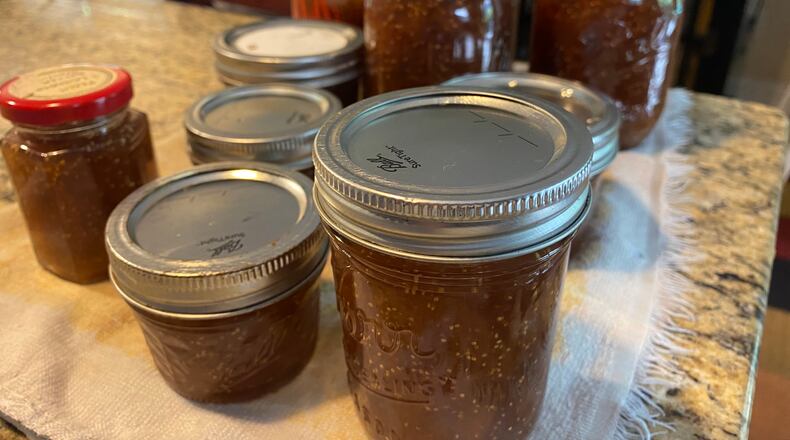The Tuesday after Labor Day always is a rough one. It’s unofficially the end of summer. Sigh.
I suppose that heat naysayers are relieved that cooler weather is on the way. I imagine those folks soon will be returning to the kitchen to make stovetop and oven dishes, after months of supping on cold pasta salads, dinners from the grill and no-heat meals, because who in their right mind ever would want to stand over a hot stove when it’s 100 degrees outside?
This gal.
I love a hot kitchen anytime, but especially during late summer, when the garden bounty is at its peak. There’s nothing like a good, old-fashioned canning session.
When it comes to preserving food, elderberries immediately come to mind. They grew in our neighbor’s yard, but the shrubs were so tall that the fruit dangled over the fence. Every year, my mom —who never turned down free food — would march back there with a big bucket and scissors and snip the umbrella-shaped purple clusters off the branches.
We’d spend hours separating the tiny orbs from the woody parts. I loved that feeling of rolling the berry off the stem with my fingers. Then it came time to extract the juice: steam the fruit in a bit of hot water, crush it, pour the pulp into a cheesecloth, and squeeze it so hard that the cloth turned purple.
I was Little Miss Helper, who measured sugar, ripped open packs of pectin, stirred in lemon juice, and got bored waiting for the sticky dark liquid to reach the gelling point. Meanwhile, Mom lit the flame under a pot filled with water; jars, lids and screw bands all needed sterilizing.
We didn’t have air conditioning. You can imagine how hot that kitchen got.
One of my favorite elderberry canning stories dates to August, 1985. The way my mom tells the story, it was very late at night, and she was funneling hot elderberry jam into Ball Mason jars. (I picture a cloud of steam hanging over the massive canner, filled with scalding water at a rolling boil. The rack is positioned inside the canner. Jar-lifter tongs are set on the counter, at the ready.)
All that remained for my mom to do was give the filled jars a hot water bath, and she finally could go to bed. She looked at the clock, cursed how late it was, and kept going.
My mom didn’t get much sleep that night, because our family of six had to wake up early the next morning to catch a plane — to London.
Even though we’d been planning that overseas vacation for nearly a year (passports, photos, currency exchange, American Express Travelers Cheques!), my mom simply could not bear to let those precious elderberries shrivel up or get eaten by the birds during her three-week absence. It was now or never, and she would not, under any circumstances, miss her opportunity. (She was pretty ticked off when the neighbors ripped out those beloved elderberry bushes a few years later.)
Credit: Ligaya Figueras
Credit: Ligaya Figueras
Thanks to my mother, I appreciate the brief window for foraging ripe serviceberries in early June, as much as the sound of popping lids that signal a properly sealed jar of goodness — the best present when opened during the barren months of winter.
By the time I had a house and family of my own, my mom was less energetic about “putting up.” She gave me her equipment and canning cookbooks, but I still preferred to can with a co-pilot. The summer I grew a windfall of tomatoes, and netted a bushel and a peck of peaches, certainly belongs in our mother-daughter canning highlights reel. Pulling the skins off hot produce is laborious; done with family or friends, it’s more like a gab session at the beauty parlor, like a scene straight out of “Steel Magnolias.”
Canning is not just a girl thing. Hitch, my former neighbor in St. Louis, is a king at this stuff. On a recent trip back to visit my mom, I stopped by to say howdy to him. I walked away with a jar of green tomato pickles in one hand and watermelon rind, mango and papaya chutney in the other.
I lamented that I didn’t have with me a proper exchange gift: one of the 10 precious jars of fig jam that I made a few weeks ago. After nearly 20 years of trying to grow figs, I finally had enough to cook with, instead of just eating them off the tree.
The lid of each glass jar is crowned with a gold seal bearing a Washington Farms stamp (a nod to my old street address) and a pineapple (symbol of hospitality). The embosser was a gift from my sister-in-law during our canning heyday.
The day I made that fig jam was one of the hottest August days in Georgia. Unlike my mom back in the day, I enjoy a kitchen with A/C. Still, the room was hot. I wished she was there to help turn pounds of fresh figs into preserves, rather than chopping and stirring by myself. It was just me, and the bubbling liquid that dared to burn my forearms.
When the jam was done, and ready to pack, I made a point to look at the clock, just like my mom. It didn’t tell me the time; it told me that I was home.
Adapted from “Ball Blue Book of Preserving” (Alltrista Consumer Products Co., 2003).
Read more stories like this by liking Atlanta Restaurant Scene on Facebook, following @ATLDiningNews on Twitter and @ajcdining on Instagram.
About the Author
The Latest
Featured




